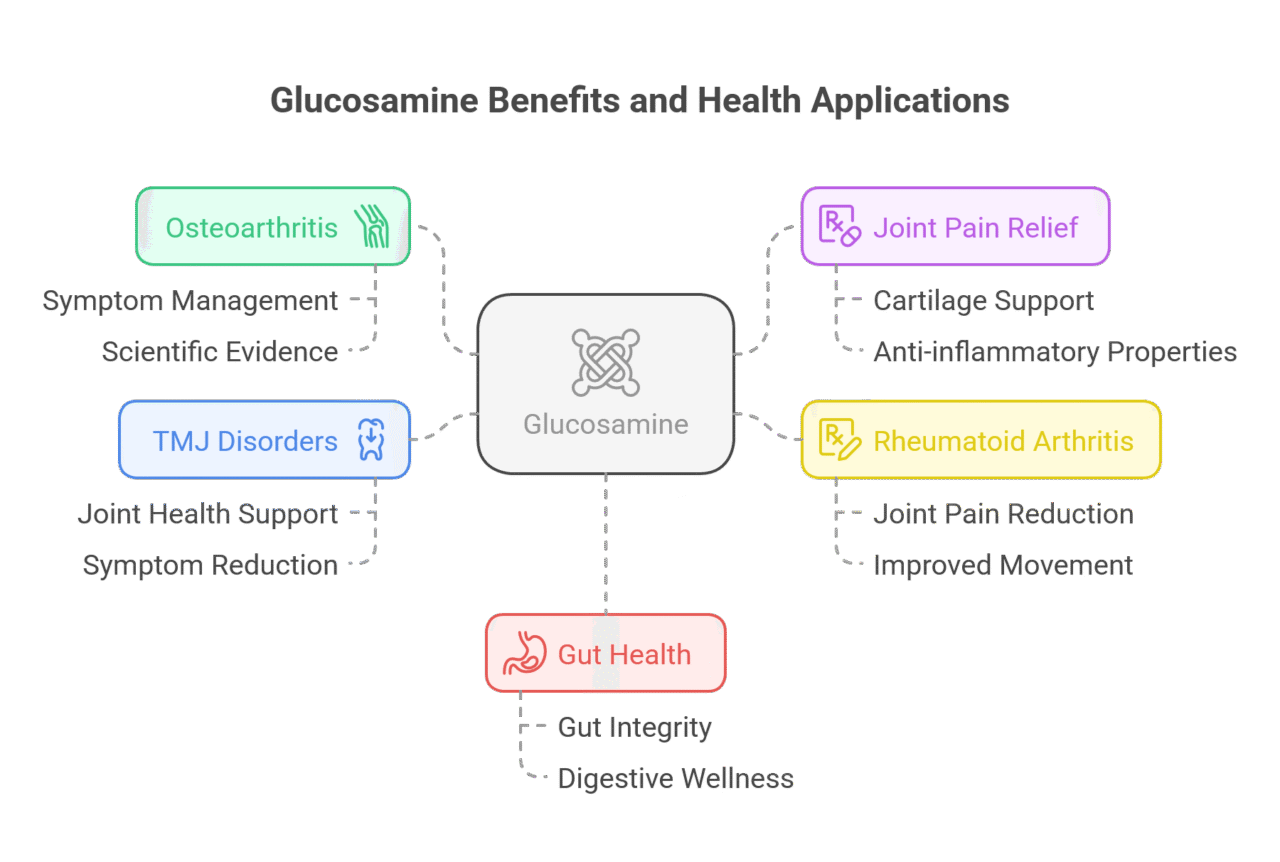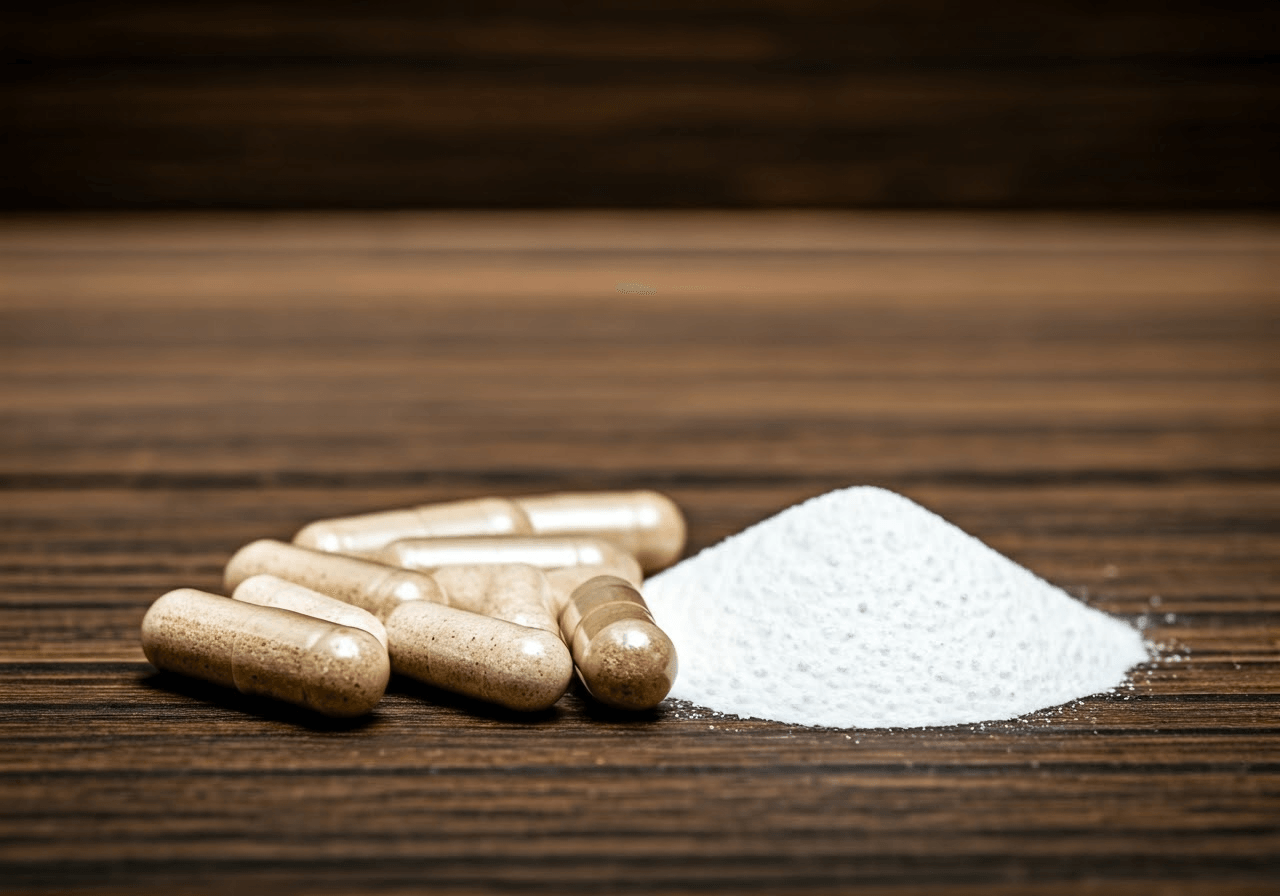
Are you dealing with joint pain, stiffness, or have trouble moving? Glucosamine is one of the most studied natural supplements for helping your joints feel better and easing pain from things like osteoarthritis. In this guide, you’ll find out what glucosamine is, what it does in your body, its main benefits, good types of supplements, and what research says about how well and safe it works. If you want to feel less pain, protect the padding around your joints, or want to know how glucosamine can be a part of your health routine, this guide is here for you.
What Is Glucosamine? Functions and Importance for Joint Health
Glucosamine is a natural substance that your body makes. It is mainly found in the fluid around your joints and in cartilage. Many people in the United States take it as a dietary supplement. They often use glucosamine to help manage joint pain and support joint health. Research about how well it works is still happening. However, many believe that it may help with symptoms of osteoarthritis and other joint problems.
Glucosamine Benefits and Uses for Joint Pain & Cartilage Health

Glucosamine is known for helping joint health and easing pain. This natural sugar is important for creating cartilage, which is the tissue that cushions our joints.
As we get older, our cartilage can wear away, leading to discomfort and stiffness. Glucosamine supplements may help slow this down and lower inflammation in the joints. Let’s look at the benefits of glucosamine that are supported by science and how it may help with different health issues.
Glucosamine for Osteoarthritis (OA): Does It Work?
For osteoarthritis (OA) treatment, glucosamine has shown promise in managing symptoms. Studies by the Osteoarthritis Research Society International highlight its potential benefits. The effectiveness of glucosamine in addressing knee osteoarthritis symptoms has been backed by scientific evidence from the National Institutes of Health. Glucosamine sulfate, a common form of supplementation, plays a significant role in the management of OA. Research suggests that glucosamine may help reduce joint pain and stiffness associated with OA. It is essential to consult a health care provider before starting glucosamine for osteoarthritis to ensure its safety and efficacy for individualized treatment. Potential users should be aware of possible interactions with medications and supplements.
Glucosamine for Joint Pain Relief & Cartilage Support
Glucosamine plays a crucial role in supporting joint pain and maintaining healthy cartilage. Research has shown that glucosamine can help alleviate joint pain, especially in conditions like osteoarthritis. By promoting the production of proteoglycans, essential components of cartilage, glucosamine aids in enhancing joint function and reducing discomfort. Its anti-inflammatory properties also contribute to relieving pain and swelling in the joints. Additionally, glucosamine supports the structural integrity of cartilage, potentially slowing down the progression of joint degeneration. For individuals suffering from joint pain or looking to maintain joint health, incorporating glucosamine into their routine may offer significant benefits in supporting overall joint function and mobility.
Glucosamine and Rheumatoid Arthritis (RA): Evidence & Benefits
Rheumatoid Arthritis (RA) is a long-lasting disease that causes inflammation in the joints, which can also contribute to long-term low back pain. This leads to pain, swelling, and stiffness. Current studies are looking into how glucosamine might help manage symptoms of RA. Research suggests that glucosamine could reduce joint pain and improve movement for people with RA. Although more clinical trials are needed to confirm these results, early findings are encouraging. Adding glucosamine to the treatment plan for RA may provide extra relief for this autoimmune disease.
Glucosamine for TMJ Disorders: Relief for Jaw Joint Pain
Temporomandibular joint (TMJ) disorders, including temporomandibular joint osteoarthritis, affect the point where the jaw connects to the skull. Studies show that glucosamine may help by supporting joint health. TMJ disorders can lead to pain, popping sounds, and stiffness in the jaw. This can make everyday activities difficult. The potential of glucosamine to ease joint pain makes it an interesting choice for TMJ patients. By helping joint movement, glucosamine may help reduce TMJ symptoms. It is important to understand how glucosamine impacts TMJ disorders, including temporomandibular joint osteoarthritis, when looking for different ways to manage these issues.
Glucosamine for Gut Health & Digestive Support
Studies have explored the effects of glucosamine on gut and digestive health. Research suggests that glucosamine may have a role in maintaining gut integrity and promoting digestive wellness. Some studies indicate that it could support the gut lining and potentially aid in conditions such as inflammatory bowel disease. However, further research is needed to fully understand the mechanisms at play and the potential benefits for gut health. Individuals considering using glucosamine for digestive issues should consult with a healthcare provider to discuss its appropriateness for their specific situation.
Glucosamine for Special Groups: Athletes, Seniors

Glucosamine is not only for people who are dealing with osteoarthritis. Two main groups—the athletes and seniors—can also get help from taking this supplement on purpose. If you want to keep your joints safe during hard exercise or keep your joints comfortable and moving well as you get older, gloucosamine may give you what you need.
Glucosamine for Athletes: Joint Protection, Recovery & Performance
Athletes often put a lot of pressure on their joints because of repeated moves and hard hits. Glucosamine may help save the part of the joint that keeps bones from rubbing against each other. It also may help joints fix themselves and cut down on swelling from too much use. There is also some proof that glucosamine can help athletes feel better faster after they work out and help keep their joints healthy as they stay active over the years.
Glucosamine for Seniors: Joint Health Benefits & Safe Dosage Tips
As people get older, their bodies make less glucosamine. This can make joints feel stiff and make it hard to move well. Taking a glucosamine supplement may help the joints feel better, keep them cushioned, and help you move around more easily. Seniors should take the normal amount, which is about 1,500 mg each day. It is also a good idea to talk to your doctor before starting, especially if you take other medicines or have health problems.
Types of Glucosamine Supplements: Which Is Best for Joint Health?

Navigating the supplement world can be confusing because there are many types and claims. Glucosamine is one of these supplements, and it comes in various forms, each with its own features.
If you want to support your joints, check its possible benefits for gut health, or you are just curious about glucosamine, knowing the differences between the types can help you make better decisions about your health.
Glucosamine Sulfate: Best Choice for Osteoarthritis?
Glucosamine sulfate is a popular form of glucosamine. Many studies have looked into its benefits for easing osteoarthritis of the knee pain, especially in weight-bearing joints like the knees. Research shows that glucosamine sulfate might help lessen pain, make joint movement easier, and slow down the worsening of osteoarthritis.
It may work by reducing inflammation and helping to make cartilage. Still, it’s important to remember that the effectiveness of glucosamine sulfate for osteoarthritis can differ from person to person. Not everyone will see big benefits.
If you are thinking about using glucosamine sulfate for joint health, talk to your doctor. They can help you figure out the right dosage and consider things like your medical history and any possible drug interactions.
Glucosamine Hydrochloride (HCl): Pros, Cons & Effectiveness
Glucosamine hydrochloride (HCL) has some good points and some not-so-good points. One good thing is that it has a higher glucosamine concentration per weight. This allows for smaller doses. It might be a better choice for people worried about shellfish allergies because it does not come from shellfish. However, some people believe that glucosamine sulfate has more scientific evidence to back its benefits for joint health. It is important to talk to a healthcare provider before picking a glucosamine supplement. This will help make sure it fits your health needs.
N-Acetyl Glucosamine (GlcNAc): Benefits for Gut, Skin & Joints
N-acetyl glucosamine (glcNAc) is important for both gut and skin health. It has many benefits. Research shows it helps keep the gut strong and the skin hydrated. GlcNAc helps make glycosaminoglycans, which are vital for keeping the gut lining and skin structure healthy. It may also help with issues like inflammatory bowel disease and can improve the skin’s barrier. By adding glcNAc to your daily routine, you might boost gut health and increase skin moisture. This can lead to better overall well-being.
Best Glucosamine Supplement Type for Joint Health
When searching for the best glucosamine for joint health, consider glucosamine sulfate as it’s well researched. Studies indicate its effectiveness in relieving osteoarthritis symptoms like pain and stiffness. Other forms like glucosamine hydrochloride and N-Acetyl glucosamine are also available but lack extensive research in comparison to glucosamine sulfate. Most studies on glucosamine’s benefits focused on glucosamine sulfate, making it challenging to compare with other types. Opting for supplements containing glucosamine sulfate is recommended for better joint health support due to its strong scientific backing.
| Feature | Glucosamine Sulfate | Glucosamine Hydrochloride (HCl) | N-Acetyl Glucosamine (GlcNAc) |
|---|---|---|---|
| Source / Form | Most studied form; typically derived from shellfish or produced through fermentation (vegan options available) | Shellfish-free; commonly made from corn, wheat, or synthetic sources (suitable for vegans) | Extracted from shellfish, fungi, or produced by fermentation (vegan-friendly options available) |
| Typical Supplement Form | Available in tablets, capsules, and powders | Found in tablets, capsules, powders, and some veterinary formulations | Available in capsules and powders; occasionally included in skincare or gut-health supplement blends |
| Main Benefits | May modestly reduce pain from osteoarthritis (OA), improve joint mobility, and slow cartilage breakdown; benefits are best documented in mild-to-moderate OA cases | Higher glucosamine content per dose; used mainly in dietary supplements for those avoiding shellfish; limited human evidence for joint pain relief | Mainly researched for digestive health (inflammatory bowel disease, leaky gut) and skin hydration; may support gut lining and skin barrier |
| Best For | Adults with osteoarthritis, particularly in weight-bearing joints like the knees and hips; most effective in early to moderate cases | Individuals seeking a shellfish-free or vegan glucosamine; more commonly used in pet and veterinary products | People with digestive issues (e.g., IBD, leaky gut) or those interested in skin health benefits |
| Commonly Combined With | Frequently paired with chondroitin, methylsulfonylmethane (MSM), or turmeric | Sometimes combined with chondroitin or MSM | Occasionally combined with hyaluronic acid or collagen in gut or skin-focused supplements |
| Potential Drawbacks | Results vary between individuals; not effective for everyone; may not be suitable for those with shellfish allergies (unless vegan-derived); modest overall effect | Lack of proven effectiveness for joint health in humans; less scientific support compared to sulfate form; primarily used in animal health products | Not clinically recommended for joint health; minimal to no evidence supporting use for cartilage or arthritis relief |
Glucosamine & Chondroitin Combination: Do They Work Better?
Combination supplements with glucosamine and chondroitin sulfate are common for joint health. These ingredients are believed to work well together. This might make their effects stronger than when taken separately.
Chondroitin sulfate, like glucosamine, is a natural part of the structure of cartilage. It may help with the strength and flexibility of cartilage. Studies about the effectiveness of glucosamine and chondroitin together are mixed. Some research shows that this combination can lead to better pain relief and better joint function for people with moderate to severe osteoarthritis than using just one of the supplements.
In the end, whether to use a combination supplement or just glucosamine should be based on your needs. It’s good to talk to a healthcare professional before making a decision.
Let’s compare how glucosamine, chondroitin, and their combination stack up side by side to help you choose the right option for your joint health needs.
| Feature / Aspect | Glucosamine (Alone) | Chondroitin (Alone) | Glucosamine & Chondroitin Combination |
|---|---|---|---|
| What it is | Natural part of cartilage structure | Natural part of cartilage structure | Contains both glucosamine and chondroitin |
| How it might work | Supports cartilage formation and repair | Helps retain water, strength, and flexibility in cartilage | Believed to provide synergistic support for joint health |
| Primary Focus | General cartilage and joint health | Cartilage strength and flexibility | Potentially enhanced joint support and pain relief |
| Effectiveness for OA (osteoarthritis) | Modest benefit for mild-to-moderate OA (mixed evidence) | Modest benefit (mixed evidence) | Mixed evidence; some studies suggest better results for moderate to severe OA, but not always significant |
| Scientific Support / Clinical Consensus | Modest clinical support; sometimes recommended for OA, but not by all major guidelines | Modest clinical support; sometimes recommended for OA, but not by all major guidelines | Not strongly recommended by most guidelines; may be tried if single supplements are ineffective |
| Who May Benefit Most | Adults with mild-to-moderate OA | Adults with mild-to-moderate OA | People with moderate to severe OA not helped by single supplements |
| Onset of Effect | 4–8 weeks of regular use | 4–8 weeks of regular use | May require 2–3 months of consistent use |
| Side Effects | Mild gastrointestinal symptoms: stomach upset, nausea, diarrhea | Mild gastrointestinal symptoms: nausea, bloating, loose stool | Similar side effects; may increase mild GI (gastrointestinal) symptoms |
| Commonly Combined With | Sometimes with chondroitin, MSM (methylsulfonylmethane), turmeric | Sometimes with glucosamine, MSM, omega-3 (fish oil) | Sometimes with MSM, omega-3, turmeric |
| Key Deciding Factor | Individual needs and response | Individual needs and response | Consider if single ingredients are not effective enough |
| Recommendation | Consult a healthcare professional before use | Consult a healthcare professional before use | Consult a healthcare professional before use |
How to Choose and Take Glucosamine Supplements for Best Results

Picking the right glucosamine supplement and learning how to use it can really help you get better results. From looking at different types of formulas to deciding when to take your dose, this section will tell you what you need to know. It will help you build a joint-care routine that fits your way of life and your health goals.
Glucosamine With Chondroitin, MSM, or Turmeric: Benefits of Combination vs Single Supplements
Some supplements mix glucosamine with chondroitin, MSM, or turmeric. This mix can help with swelling and help the joints feel better. These blends might give more good support for the joints than using glucosamine by itself. But, results are not the same for all people. Research also shows different outcomes, so you should talk to your doctor to find what will work best for you.
Below is a quick comparison of popular glucosamine supplement combinations, so you can decide which is best for your joint health goals.
| Supplement Type | Main Benefits | Common Uses | Potential Drawbacks | Best For |
|---|---|---|---|---|
| Glucosamine Only | Joint pain relief, supports cartilage health | Mild-to-moderate osteoarthritis (OA), general joint health | Mild GI (gastrointestinal) upset, variable effectiveness | People with mild OA or sensitive to combinations |
| Glucosamine + Chondroitin | Enhanced joint support, may improve cartilage flexibility | Moderate-to-severe OA, cartilage wear | Higher cost, possible GI side effects | People with more severe OA or limited benefit from glucosamine alone |
| Glucosamine + MSM (methylsulfonylmethane) | Anti-inflammatory, may improve mobility | Joint inflammation, muscle soreness | Limited research, possible GI upset | Active adults, those with joint inflammation |
| Glucosamine + Turmeric | Joint pain relief, anti-inflammatory, antioxidant | Arthritis, joint stiffness | May interact with blood thinners | People wanting natural inflammation support |
Vegan Glucosamine: Plant-Based Supplement Options & Effectiveness
Traditional glucosamine usually comes from shellfish. Because of this, it is not good for people who eat vegan or have shellfish allergies. There are now plant-based choices made from things like corn that has been fermented or certain fungi. These options do not have any allergens from shellfish. Vegan glucosamine can also help support joint health in much the same way as the old kind. You can get it from many places now.
How to Take Glucosamine: Forms, Dosage & Absorption Rates

Knowing how to use glucosamine daily can maximize its benefits. Glucosamine has various forms, each absorbed differently. Let’s explore these methods to help you choose the best option for your health and routine.
Glucosamine Capsules & Tablets: Most Convenient Option?
Capsules and tablets are popular for taking glucosamine. They ensure the right dose and fit into routines easily. These forms undergo a consistent manufacturing process, providing the same active ingredient amount per serving.
Capsules are easier to swallow than tablets for some. The capsule’s outer shell helps it go down smoothly. Tablets may be cheaper per piece than capsules.
It is crucial to follow the recommended dose, regardless of your preference for capsules or tablets. Consulting your healthcare provider is essential for safe and effective use of glucosamine in your health routine.
Glucosamine Powders & Drinks: Fastest Absorption?
Glucosamine powder offers flexibility and quick absorption. You can easily adjust the dose by mixing it with drinks. Some believe powder absorbs better, but scientific proof is lacking. Choose reputable brands for quality. Consult a healthcare provider for dosage and safety.
Liquid Glucosamine: Is It More Effective Than Pills?
Liquid glucosamine is simple to take, good for those who struggle with pills. It’s easy to measure like powders. The effectiveness of glucosamine isn’t linked to its form. Limited research on liquid absorption compared to other forms exists.
Choose based on preference and convenience. If unsure, consult your doctor or dietitian for personalized advice on glucosamine effectiveness.
Glucosamine Creams: Do Topical Products Work for Joint Pain?
Topical creams with glucosamine are popular for joint pain relief. You apply them on your skin where it hurts. People hope this brings quick relief. Research is ongoing to confirm their effectiveness for joint pain.
Some believe applying glucosamine helps it reach joints easily. However, scientific proof is lacking. Research shows varied results on glucosamine absorption through the skin to the joints.
Injectable Glucosamine: Who Should Consider It?
Injectable glucosamine is rare. It’s mainly for specific medical purposes and not commonly as a supplement. This kind of glucosamine goes straight into a joint, managed by a healthcare professional.
People might require it if they can’t use oral glucosamine, maybe from severe stomach issues hindering absorption or no results from oral methods.
If you think about using injectable glucosamine, consult with a qualified healthcare provider to assess your needs and discuss benefits, risks, and alternatives.
| Feature / Form | Capsules & Tablets | Powders & Drinks | Liquid Glucosamine | Topical Creams | Injectable Glucosamine |
|---|---|---|---|---|---|
| How Used | Swallowed whole | Mixed with drink | Measured and drunk | Applied to skin over joint | Injected into joint by professional |
| Convenience | High (pre-measured, portable) | Moderate (requires mixing) | High (no pills, easy to measure) | High (localized application) | Low (requires medical appointment) |
| Dosage Control | Precise (fixed per unit) | Flexible (easy to adjust) | Flexible (easy to measure) | Less precise (localized) | Precise (administered by professional) |
| Absorption/Action | Standard oral absorption | May be faster (not proven) | May be faster (limited evidence) | Through skin (effectiveness debated) | Direct to joint, local effect |
| Scientific Support | Well-studied for oral supplements | No proven absorption advantage | Limited research vs. oral forms | Ongoing research, weak evidence | Used for specific medical needs |
| Key Benefits | Consistent dose, widely available | Custom dosing, good for pill aversion | Easy for those who dislike pills | Localized pain relief | Direct delivery when oral not possible |
| Potential Drawbacks | Tablets can be hard to swallow for some; capsules may be more expensive | Taste, fillers/sweeteners, quality varies | Shorter shelf life, additives | Limited joint penetration proof | Invasive, rare, high cost, requires a professional |
| Best For | Routine users, consistent dosing | Those needing flexible dosing | Pill-averse, want liquids | Added relief for joint discomfort | Severe cases, oral forms not tolerated |
Glucosamine Dosage Guide & Best Time to Take for Results
The right dose of glucosamine can change based on personal details like age, weight, health, and why you are taking it. For most adults, the usual recommended dose is 1,500 milligrams (mg) each day. It can be taken in two or three smaller doses.
Studies show that taking glucosamine every day might help you see its benefits. It may take weeks or even months of regular use to notice any real differences in how your joints feel and move. There is no clear proof about the best time to take glucosamine, so it doesn’t matter much when you have it during the day.
Here’s a quick guide that summarizes the key dosage tips and timing recommendations based on current research and clinical advice:
| Aspect | Recommendation / Information |
|---|---|
| Standard Daily Dosage | 1,500 milligrams (mg) per day for most adults. |
| Maximum Safe Dosage | Do not exceed 2,000 mg per day unless advised by your healthcare provider. |
| How to Take | Once daily, or split into 2–3 smaller doses. |
| Factors Influencing Dose | Age, weight, overall health, and your specific reason for taking glucosamine. |
| Best Time to Take | No specific “best” time; can be taken at any convenient time of day. |
| With or Without Food | With meals is preferred (may reduce stomach upset), but not strictly necessary. |
| Consistency | Take glucosamine every day; regular use is key for results. |
| Time to Notice Results | May take several weeks or even months of consistent use to experience joint benefits. |
| Possible Side Effects | Usually mild: stomach upset, nausea, diarrhea; may affect blood sugar. Rare: allergic reactions, especially with shellfish-derived products. |
| Important Note | Consult a healthcare professional to determine the best dosage and schedule for your individual needs. |
Natural & Vegan Sources of Glucosamine in Food

Glucosamine supplements are easy to find. However, it’s not common in regular foods. The main source is shellfish shells like shrimp and crab. Yet, the amount is minimal. It can be challenging to consume enough for health benefits. Moreover, these foods may not suit those allergic to shellfish. Additionally, most glucosamine in shells is from parts people usually don’t eat.
Animal-Based Glucosamine Sources: Shellfish, Broth & Cartilage
Shellfish Shells (Shrimp, Crab, Lobster)
The shells of shellfish are full of glucosamine, a compound taken from their chitin structure. Glucosamine is found in supplements. Shellfish meat lacks glucosamine, but their shells have plenty.
Bone Broth & Animal Cartilage
Harness the benefits of glucosamine for joints. It’s found in beef, pork, and chicken cartilage. You can get it from homemade bone broth by simmering bones for hours. This process also releases collagen and chondroitin, supporting joint health. Chicken feet, oxtail, or cartilage-rich meat can also offer some glucosamine.
Animal Joints & Connective Tissue
Glucosamine is in animal joints, tendons, and tissues. Foods like chicken wings have some. Also, dishes with bone-in meats may have glucosamine. These foods are good sources.
Here’s a quick breakdown of the top animal-based sources of glucosamine, their nutritional value, and how to include them in your diet:
| Food Source | Estimated Glucosamine Potential (Food-Based) | Other Notable Nutrients / Benefits | Tips for Consumption / Considerations |
|---|---|---|---|
| Shrimp Shells | High (in chitin — not directly edible) | Chondroitin, glycosaminoglycans, calcium | Not edible as-is. Glucosamine is extracted industrially. Avoid if allergic to shellfish. |
| Crab Shells | High (main commercial source for supplements) | Chondroitin, trace minerals | Not eaten directly. Used to make glucosamine sulfate supplements. |
| Lobster Shells | High (in shells only) | Trace glucosamine, some protein in meat | Can be simmered for broth. Shell contains chitin-based compounds. |
| Chicken Feet | Moderate to High | Collagen, gelatin, protein | Use in broths. Simmer for 6–12 hours to release joint-supportive nutrients. |
| Pork Hocks / Pork Skin | Moderate | Collagen, gelatin, protein | Cook until tender. May be high in fat—trim if needed. |
| Oxtail | Moderate | Collagen, cartilage, glycosaminoglycans | Great for stews and soups. Rich in connective tissue. |
| Beef Tendons | Moderate | Glycosaminoglycans, protein | Requires long, slow cooking. Popular in traditional Asian dishes. |
| Chicken / Turkey Necks | Moderate | Collagen, cartilage, protein | Affordable broth base. Simmer to soften and extract joint-nourishing elements. |
| Bone Broth (Beef / Chicken Bones) | Variable (depends on simmer time & bones used) | Collagen, glucosamine, chondroitin, calcium, magnesium | Simmer with vinegar for 12–24 hrs. Homemade broth supports joint and gut health. |
| Cartilage-Rich Meat Cuts | Low to Moderate | Small amounts of glucosamine, collagen | Include chicken wings, drumsticks, or rib tips in stews to get cartilage content. |
Plant-Based & Alternative Glucosamine: Vegan and Fungi Options
Fungi (Mushrooms)
The title of the blog is “Use Glucosamine for Healthy Joints.” Some mushrooms, such as shiitake and maitake, have chitin, similar to glucosamine. Although mushrooms don’t have glucosamine directly, researchers are studying them as a natural source of the substance.
Fermented Corn (Vegan Glucosamine)
Since plants don’t naturally produce glucosamine, vegan glucosamine supplements are often made from fermented corn or other plant-based fermentation processes. This method creates a 100% plant-based glucosamine that mimics the kind found in shellfish. It’s a great alternative for those who want the benefits of glucosamine without consuming animal products.
Here’s a quick look at the top plant-based and alternative sources of glucosamine, their nutritional value, and how they fit into a vegan-friendly wellness routine:
| Food Source | Estimated Glucosamine Potential (Food-Based) | Other Notable Nutrients / Benefits | Tips for Consumption / Considerations |
|---|---|---|---|
| Vegan Glucosamine Supplements (Fermented Corn, Fungi, etc.) | High (bio-identical to animal-based glucosamine) | 100% plant-based; allergen-free; vegan/vegetarian-friendly | Widely available as “vegan glucosamine.” Choose supplements with third-party certifications for purity. |
| Chitosan Supplements (Fungi-derived) | Moderate (precursor to glucosamine) | Fiber-like polysaccharides; may support gut health | Not actual glucosamine but chemically related; sometimes included in vegan joint blends. |
| Fungi (Mushrooms: Shiitake, Maitake, White Button, etc.) | Low (contains chitin, a glucosamine precursor) | Beta-glucans, B vitamins, vitamin D, antioxidants | Eat cooked. Chitin is not efficiently converted to glucosamine in humans; not a therapeutic source. |
| Aspergillus niger (used in fermentation) | High (as supplement ingredient) | Not relevant as a direct food source | Not a food; used industrially for fermenting plant-based glucosamine in supplements. |
| Seaweed (Red Algae, Kelp) | Low (contains some glucosamine-like compounds) | Iodine, calcium, magnesium, polysaccharides | Eat as salads or soups for mineral content; glucosamine content is negligible for joint health. |
Glucosamine Side Effects, Safety & Drug Interactions

Glucosamine is usually safe for most people if taken as directed. However, like any supplement, it’s important to know about possible side effects and the safety of glucosamine. issues.Understanding the risks and talking to your healthcare provider can help you make good choices about using glucosamine.
Being open with your healthcare provider about your medical history, current medications, and supplements can lead to better advice. It also helps to avoid any complications.
Common Glucosamine Side Effects & How to Reduce Risks
Most side effects of glucosamine are mild and affect the stomach. Common problems include upset stomach, heartburn, diarrhea, and nausea. Usually, these issues go away as your body gets used to the supplement.
You can help reduce these problems by starting with a lower dose and slowly increasing it to the normal amount. It can also help to take glucosamine with food or split your daily dose into smaller doses throughout the day. In rare situations, glucosamine might cause serious allergic reactions, especially for those with shellfish allergies, since some glucosamine products come from shellfish shells.
Here’s a quick overview of the most common side effects of glucosamine and simple ways to minimize the risks:
| Side Effect Category | Typical Symptoms / Examples | How to Reduce Risk / What to Do |
|---|---|---|
| Digestive Upset | Nausea, heartburn, diarrhea, constipation, gas, stomach pain | Take with food or meals. Split daily dose (e.g., 500 mg 3×/day instead of 1,500 mg once). Start with a low dose and increase gradually. Ensure adequate fluid intake. |
| Allergic Reactions | Skin rash, itching, hives, swelling, difficulty breathing | Avoid if you have shellfish allergy—choose vegan glucosamine. Always check product labels for source. Discontinue and seek medical attention if symptoms develop. |
| Headache / Drowsiness | Mild headache, sleepiness, fatigue | Stay well-hydrated. Consider dosing at a different time of day. Lower dose or consult your doctor if symptoms persist. |
| Blood Sugar Changes | Mild increase in blood glucose (rare; mostly in diabetics) | Monitor blood sugar if diabetic. Consult your healthcare provider before starting glucosamine if you have diabetes or are at risk. |
| Blood Thinning / Drug Interactions | Easy bruising, bleeding gums (esp. with blood thinners) | Inform your doctor of all medications and supplements, especially if taking warfarin or chemotherapy drugs. Only use glucosamine if cleared and monitored by your doctor. |
Glucosamine Interactions: Medications & Supplement Safety
It is very important to know about possible drug interactions when using glucosamine. It can change how some medications work or raise the chance of side effects. For example, glucosamine may work with blood thinners like warfarin and increase their effects.
If you are using blood thinners or other drugs, like diabetes medications, you should talk to your doctor or pharmacist before starting glucosamine. They can check for any interactions, change dosages if needed, and keep an eye on you for any adverse effects.
Below is a summary of common medication and supplement interactions with glucosamine, including potential risks and what to do for your safety.
| Interaction Type (Examples) | Nature of Potential Interaction | Potential Effect / Risk | Safety Tips / What to Do |
|---|---|---|---|
| Blood Thinners (Warfarin, Coumadin, anticoagulants) | Possible additive blood-thinning effect | Increased risk of bleeding | Consult your doctor before use. May need extra monitoring (International Normalized Ratio, INR). |
| Diabetes Medications (Insulin, metformin, etc.) | May affect insulin sensitivity or glucose metabolism | Possible impact on blood sugar control | Monitor blood glucose closely. Adjust diabetes meds only under doctor supervision. |
| Chemotherapy Drugs (Doxorubicin, etoposide, etc.) | May interfere with drug metabolism or effectiveness | Possible reduced effectiveness of some chemotherapy drugs | Always discuss with your oncologist before taking glucosamine. |
| NSAIDs / Pain Relievers (Ibuprofen, naproxen, etc.) | No direct drug interaction; both target joint pain | No major direct interaction, but both used for joint pain | May allow for lower NSAID dose, but always consult your healthcare provider. |
| Other Supplements (Chondroitin, MSM, turmeric, fish oil) | Potential overlapping effects on blood clotting | May increase effects or side effects (especially bleeding risk) | Inform your doctor of all supplements. Avoid high-dose combinations unless monitored. |
| Shellfish Allergy Concern | Allergen cross-reactivity (shellfish-derived) | Allergic reaction if glucosamine is derived from shellfish | Choose vegan or plant-based glucosamine if allergic. Always check product labels. |
| Children, Pregnant, Nursing | Lack of safety data | Safety not established | Use only under strict medical supervision. Not generally recommended without a doctor’s advice. |
Who Should Avoid Glucosamine? Contraindications & Warnings
Glucosamine is mostly safe for adults. However, some should avoid or use it cautiously due to risks. People allergic to shellfish must be cautious with glucosamine as it’s often derived from shellfish. Choose shellfish-free products or consult your doctor for alternatives.
If you have diabetes or take diabetes drugs, talk to your doctor before using glucosamine, especially if you have heart disease. It could slightly impact blood sugar levels and may raise blood pressure. Monitor your blood sugar carefully, especially when starting or altering the glucosamine dose.
The table below shows which groups should avoid or use glucosamine with caution, and what actions are recommended.
| Group / Condition | Reason / Risk | Level of Concern | Recommended Action |
|---|---|---|---|
| Shellfish Allergy | Most glucosamine is shellfish-derived (crab, shrimp, lobster); can trigger allergy | High (potentially severe) | Strictly avoid shellfish-based products. Choose vegan/fermented corn glucosamine. |
| Blood Thinner Use (Warfarin, Coumadin, etc.) | Can increase risk of bleeding by potentiating drug effects | High (potentially severe) | Only use with physician approval & frequent INR checks; often best to avoid. |
| Known Glucosamine Sensitivity | Past history of adverse reactions (rash, GI upset, swelling, etc.) | High | Avoid glucosamine and seek alternatives. |
| Chemotherapy (certain drugs) | May interfere with effectiveness of some chemo drugs | High (avoid unless approved) | Do not use unless specifically allowed by your oncologist. |
| Pregnant or Breastfeeding Women | Insufficient safety data; unknown fetal/infant risk | Generally avoid | Use only if prescribed by a healthcare provider for a specific reason. |
| Children & Adolescents (<18 years) | Not studied for safety/effectiveness in this age group | Generally avoid | Only use if prescribed by a pediatrician and closely monitored. |
| Scheduled Surgery | Possible impact on blood clotting and blood sugar | Moderate | Discontinue at least 2 weeks before surgery; inform surgical team. |
| Diabetes / Insulin Resistance | May (rarely) affect blood sugar or insulin sensitivity | Use with caution | Consult your doctor; monitor blood glucose if used. |
| Asthma History | Rare reports of worsening symptoms (case studies) | Use with caution | Discuss with your doctor before starting; monitor symptoms. |
| Glaucoma or Ocular Hypertension | Possible increased intraocular pressure (rare/controversial) | Use with caution | Consult ophthalmologist before use if you have glaucoma or high eye pressure. |
| Severe Liver or Kidney Disease | Limited safety data; unknown effects on organ-compromised patients | Use with caution | Only under specialist supervision. |
Conclusion
Researchers are studying glucosamine for health benefits beyond joints. It may help with inflammation-related conditions like stomach problems and skin issues. Early clinical studies show potential, but more extensive systematic review research is needed. Current data is mainly from animal studies or small human trials. Larger, well-designed studies are necessary to determine effectiveness, safe doses, and long-term effects of glucosamine on various health problems.
The content on WellwayHub.com is intended for general informational purposes only and should not be taken as medical advice. Please consult your doctor or a qualified health professional before making any changes to your health routine.
Some links on WellwayHub.com may be affiliate links. This means we may earn a small commission if you make a purchase through these links, at no extra cost to you. This helps support our mission to provide trusted wellness content.
Frequently Asked Questions
Glucosamine is usually safe for most people. However, its safety can differ based on personal health factors. It’s a good idea to talk to your healthcare provider. This is especially true if you have existing health issues, allergies, or if you are pregnant or breastfeeding.
Glucosamine supplements are usually safe for most people, but they can have some side effects. Some people may feel pain in the stomach, feel sick, or have diarrhea. A few may feel dizzy, sleepy, or get headaches. Some can have allergic reactions. If you feel bad after taking it, talk to your doctor. This way, you can know if it is good for you.
Glucosamine is generally considered safe for long-term use, especially when taken within recommended dosages. However, as with any supplement or medication, it’s important to consult with a healthcare professional before starting long-term use of glucosamine, particularly if you have any underlying health conditions or are taking other medications. Some potential side effects of glucosamine may include gastrointestinal issues like upset stomach or diarrhea. Monitoring your symptoms and discussing any concerns with your healthcare provider can help ensure the safety and effectiveness of using glucosamine for an extended period.
Yes. Many older people use glucosamine to help with moving around and to ease joint pain. The usual amount is 1,500 mg each day. But you should ask about medicine mix-ups before taking it.
Glucosamine mainly comes from the shells of shellfish, which are not suitable for vegans. But some companies make vegan glucosamine from plant sources, like fermented corn.
Yes, it is good to use this every day. You need to take it daily to get the most out of it. If you skip a day, it may not work as well to help with joint health and everyday joint pain.
There is not one best time to take it. A lot of people take it with food because that can help stop stomach pain. You can also take the dose in smaller amounts, like 500 mg three times a day. This can help your body take in more of it and can lower the chance of side effects.
The time it takes for glucosamine to work can differ. You might need to use it regularly for several weeks or even a few months before you see noticeable changes. If you don’t see improvements in that time, you should talk to your doctor.
Yes, glucosamine sulfate can help with the symptoms of osteoarthritis, especially in the knees and hips. It can reduce pain and stiffness. It might also help slow down the breakdown of cartilage.
Glucosamine is commonly used to help joints, but we do not completely know how well it works for sports injuries, especially in high risk cases. It is best to talk to your doctor or a sports medicine expert for the right treatment and recovery plans.